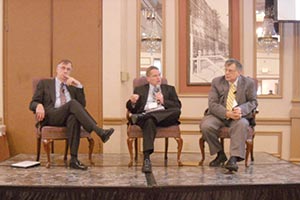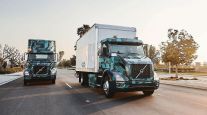GHG Rule to Boost Costs

This story appears in the April 4 print edition of Transport Topics.
COLUMBUS, Ind. — Regulation of greenhouse-gas emissions could increase the cost of a tractor-trailer combination by almost $14,250 through 2027, participants said at an ACT Research Co. seminar here, cautioning the regulation also could cause a pre-buy cycle of trucks similar to a decade ago.
They added that the greenhouse-gas rule’s Phase 2, jointly issued by the Environmental Protection Agency and the National Highway Traffic Safety Administration, also could be complicated by California, which wants to regulate nitrogen oxide emissions.
Cutting carbon dioxide and nitrogen oxides simultaneously is a daunting engineering challenge, they said March 30, because very hot combustion improves engine efficiency but creates nitrogen oxide, while cooler combustion boosts carbon dioxide output.
The proposal for Phase 2, published last year, did not include changes in nitrogen oxide limits, but California has the right to act independently.
EPA has said that it will publish the final version of Phase 2 during August — to be implemented between 2017 and 2027.
Unlike the regulation of truck engines for nitrogen oxide and particulate matter, Phases 1 and 2 of the rule do offer fleets the promise of superior fuel economy, but at a cost, said Glen Kedzie, energy and environmental affairs counsel for American Trucking Associations and a former EPA attorney.
In a separate presentation, ACT President Kenny Vieth forecast the rule will cut into North American truck production and sales.
Heavy-duty production should hit 327,000 vehicles in 2020 and fall to 199,000 in 2021, a decline of 39% in North America.
Vieth’s 2020 production estimate is slightly higher than the 323,000 Class 8s built last year. For this year, he predicts production will drop to 237,000 units.
Meanwhile, retail sales are expected to behave similarly, falling from 308,000 in 2020 to 248,000 in 2021, down 19.5%.
“There are potentially favorable conditions for pre-buying,” Vieth said in unveiling his firm’s forecast. “Low fuel prices would extend the fuel-efficiency payback period” envisioned by federal regulators, he added.
Sales of big trucks boomed in 2005 and 2006 ahead of a January 2007 regulatory tightening of emissions levels. Fleets were described as pre-buying much of their 2007 and 2008 volumes, marking two years of sharply declining sales.
Kedzie compared 2017 tractor-trailers, when Phase 1 is fully implemented, with big rigs to come during Phase 2, which will have pollution-control technology on diesel engines, tractors and 53-foot trailers. Using the proposed rule and its supplementary documents as a guideline, Kedzie said the cost additions would be about $8,700 in 2021 (the first stage of
the Phase 2 rule), $12,300 in 2024 (second stage) and $14,250 per tractor-trailer in 2027 that marks the rule’s final stage.
The California Air Resources Board could tighten its standards for nitrogen oxide in 2024, causing another glitch.
CARB has said it wants to lower the ceiling on nitrogen oxide output to 0.02 gram per brake horsepower-hour from the current limit of 0.2 gram, a decrease of 90%, and is funding a research program to explore and investigate the feasibility of the reduction.
“We are evaluating enhanced aftertreatment technology choices, aftertreatment configurations, improved
and more efficient catalyst, improved aftertreatment thermal management, urea dosing strategies and engine management practices for two heavy-duty engines: one natural-gas engine with a three-way catalyst, and one diesel engine with a diesel particulate filter and selective catalytic reduction reducing nitrogen oxide emissions,” CARB said.
If CARB wants to change the limits within California, the agency probably would have to announce its intentions this year, Kedzie said.
Such a change could affect truck engines nationwide, said Sean Waters, director of product compliance for Daimler Trucks North America, because engine makers will not want to manufacture separate engines for California and the rest of the nation.
“There won’t be two production lines, and you can’t rein in California,” Kedzie said.
CARB also is much on the mind of Thermo King, the manufacturer of refrigerated units, said Todd Lutkauskas, the company’s strategic marketing manager.
The California agency is addressing trailer refrigerated units from two angles, Lutkauskas said: limiting the time they can run on diesel when they could instead be plugged into an electrical outlet and switching reefer fuel from diesel to hydrogen fuel cells.
He said the switch to hydrogen fuel cells would be difficult because truck operators prefer to power their reefer units with the same fuel they use in tractors.
“We’re an afterthought,” he said of the reefer business. “People buy a tractor first, then a trailer and finally a reefer unit.”




